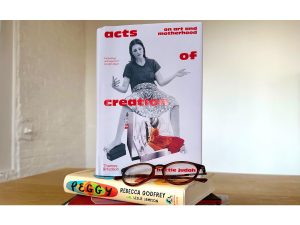“Orgasms Happened Here” features new work by the New York–based artist Diamond Stingily (b. 1990). Stingily‘s multidisciplinary practice traverses varied fictive, biographical, and autobiographical narratives to recast the symbolic order that governs everyday objects. Throughout 52 Walker, she has installed a series of site-specific architectural interventions that evoke the colors, scale, and ambience of suburban American households and places of worship. These interstitial spaces, as well as the gallery itself, serve as portals into the whimsical and dark memories that are often suppressed in the name of adult decorum, revealing glimpses of the libidinal longing secretly stored in the artist‘s and our own collective imaginations.
The exhibition title is taken from the artist‘s childhood memories: when Stingily‘s family first moved into the home where she spent her adolescence, her brother discovered a sticky note affixed above the door of a closet in his bedroom that read “orgasms happened here.” In her presentation at 52 Walker, Stingily zeros in on the closet and other thresholds—locked doors, stained-glass windows, and ready-made gate sculptures— that symbolize privacy, transition, curiosity, and transgression. The artist further relates the exhibition to the French folktale of Bluebeard, in which the titular nobleman‘s wife unlocks a forbidden door of his castle and discovers all of his previous wives inside the mysterious chambers.
The new works in “Orgasms Happened Here” build on existing forms from Stingily‘s oeuvre. At 52 Walker, a number of closets are inset into the built environment of the gallery, with each interior designed to allude to a particular theme and represent a conduit that may transport the viewer to other worlds. One features a crumbling brick wall that pays homage to the iconic paintings of queer American artist Martin Wong (1946–99); another, a series of propped baseball bats. The visual references Stingily includes are both vague and specific, humorous and dark—the individual closets are composites of varied memories and emotions that reflect the space‘s capacity to reveal and conceal, as well as its ability to capture tensions created by different characters and settings from all points in time.
Also on view are stained-glass windows that are set into walls or presented as stand- alone sculptures. The windows are each partially covered by soft yellow organza curtains, further filtering the already glowing light that fills the space. The architectural forms take on the art deco style of Stingily‘s great-great-aunt‘s Baptist church in Chicago. Operating at a remove from the religious worship practiced by her elder family members, Stingily connects the sanctuary of the church‘s urban community space to that of the suburban adolescent bedroom. Here, she reflects on the generational differences between grandparents, parents, and children: what changes or what might stay the same within households, how structures they inhabit might shift according to the locales in which they reside, and how these contrasts shape discrete notions of shame and desire.
To complement the windows and closets, Stingily has dispersed a number of her door and iron fence sculptures throughout the gallery. Although these objects maintain their tough exteriors, these portals recalibrate their normal limitations and boundaries when removed from their usual contexts—a theme with which Stingily has engaged throughout her practice. Although they are not used within this space for their primary function of defense, the gates maintain their purpose of guardianship. Their swirling metal constructions appear more decorative and ornamental, their loops and whorls rendered elegant and feminine. The doors beckon unfamiliar experiences, and yet their locks promise safety and security. Human-scale and made from everyday objects, these works serve as subtle reminders of the restrictions between the domestic and the public as well as a record of the evolving ways in which we try to keep ourselves safe.
at 52 Walker, New York
until September 14, 2024




